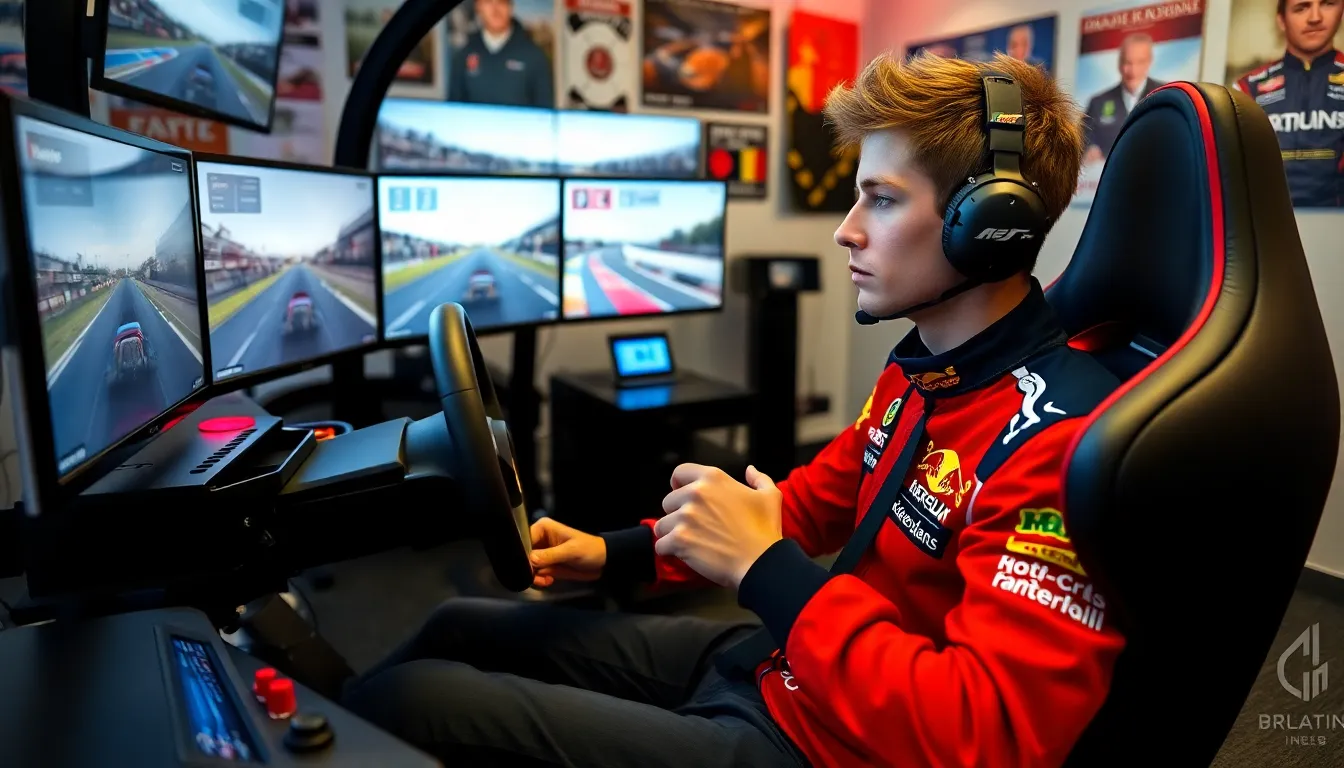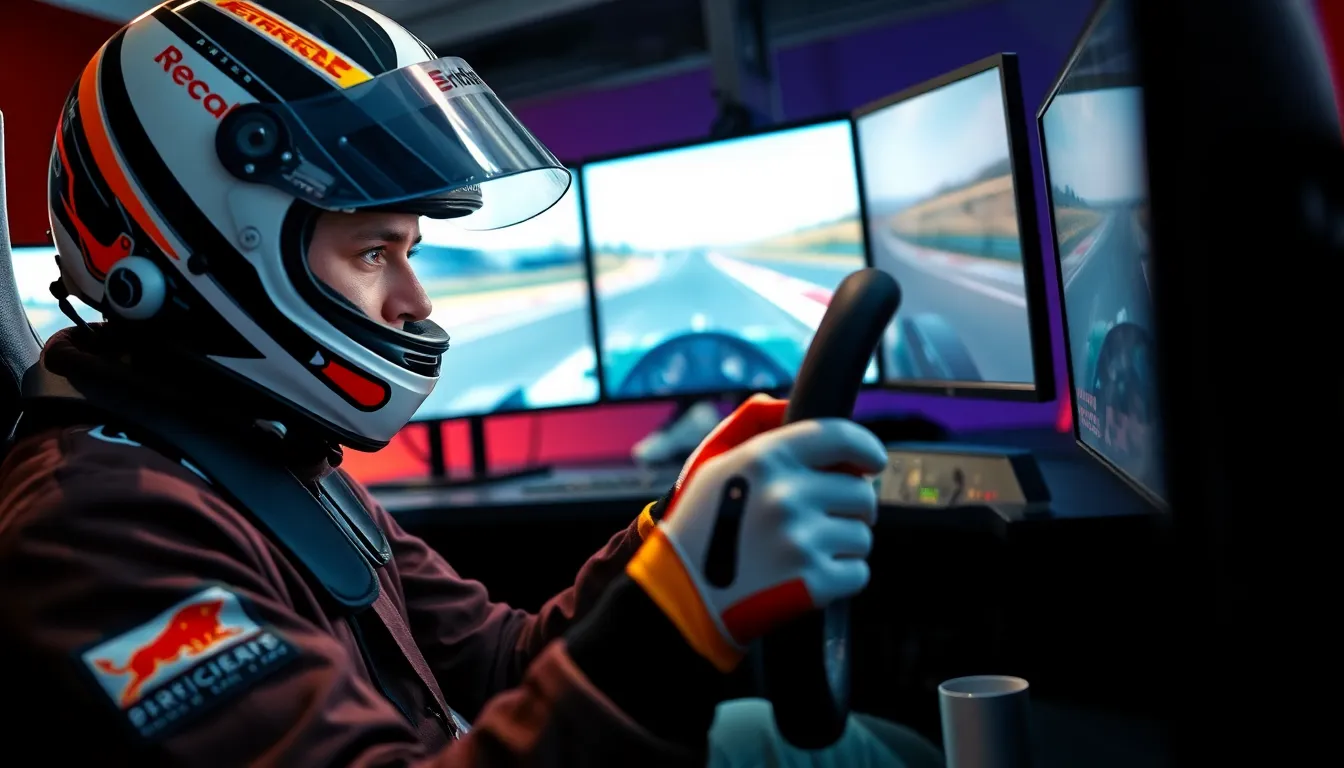
Max Verstappen Sim Racing: Discover the Champion’s Thrilling Virtual Adventures
Max Verstappen isn’t just tearing up the Formula 1 tracks; he’s also making waves in the world of sim racing. Picture this: the reigning world champion, trading in his high-speed Red Bull for a virtual cockpit, where the stakes are just as thrilling but without the risk of a pit stop disaster. It’s the perfect blend of adrenaline and pixels, and fans can’t get enough.
Sim racing has become a playground for Verstappen, showcasing his skills in a whole new arena. With his lightning-fast reflexes and tactical genius, he proves that racing isn’t just about the car; it’s about the driver behind the wheel—whether that’s in real life or on a screen. So buckle up as we dive into the exhilarating world of Max Verstappen’s sim racing adventures, where the only thing more exciting than his overtakes is the banter that comes with it.
Max Verstappen A Sim Racing Pioneer
Max Verstappen excels as a sim racing competitor, showcasing his remarkable abilities in a virtual environment. His quick reflexes contribute significantly to achieving impressive results against other skilled racers. In various competitions, he demonstrates strategic thinking that mirrors his real-life Formula 1 performances. Fans often witness the excitement of his races, where he consistently pushes the limits of virtual racing.
Leading events like the Formula 1 Esports Series, Verstappen brings attention to sim racing. His participation elevates the sport’s profile, attracting new audiences and inspiring aspiring racers. Competitors regard him as a benchmark, motivating them to improve their skills and strategies. Teaming up with established virtual racing brands further solidifies his role as a key influencer in this domain.
Social media posts reveal his engagement with other racing enthusiasts and fellow drivers. Often, he shares insights and experiences that resonate with fans, fostering a sense of community around sim racing. Engaging in tournaments such as the 24 Hours of Le Mans Virtual, Verstappen shows his commitment to both sim racing and his fans.
Appreciation for his contributions extends beyond the virtual circuits. Recognized for bridging the gap between real and virtual racing, he ensures that both worlds benefit from the evolution of racing technology. Sim racing becomes more mainstream as he participates in and promotes various events, highlighting the thrill and strategy involved in this captivating sport.
The Rise of Sim Racing

Sim racing has emerged as a prominent niche in the motorsports landscape, attracting a broad audience. Many drivers, including Max Verstappen, embrace this digital form of racing, showcasing their skills in a virtual environment.
What is Sim Racing?
Sim racing simulates real-world racing experiences through advanced software and hardware. These racing simulations replicate vehicle dynamics and track conditions, offering an authentic racing experience. Players use racing wheels and pedals to enhance their realism during gameplay. Additionally, simulation titles often include lifelike graphics and physics, making the virtual experience even more immersive. Competitors engage in various formats, from time trials to multi-hour endurance races. Many professionals utilize sim racing to refine their skills and strategies, demonstrating its value as a training tool.
Popular Sim Racing Platforms
Several platforms dominate the sim racing scene, each catering to different preferences. iRacing stands out for its intense competitiveness and subscription model, ideal for serious racers. Assetto Corsa offers a high degree of customization, enabling players to modify cars and tracks extensively. Alternatively, Gran Turismo and Forza Motorsport attract a wider audience with their user-friendly interfaces and accessibility. Each platform features regular updates and events, enhancing community engagement. Esports competitions, such as the Formula 1 Esports Series, capitalize on these platforms, providing thrilling tournaments that draw significant viewer interest.
Max Verstappen’s Journey in Sim Racing
Max Verstappen’s affinity for sim racing has evolved over the years, reflecting his commitment to both competitive gaming and motorsport. He first engaged with sim racing in his youth, leveraging it as a training tool that complements his physical racing endeavors.
Early Interest and Involvement
Interest in sim racing sparked at a young age for Verstappen. His father, Jos Verstappen, a former Formula 1 driver, introduced him to various racing games. Immersion in this digital world provided an effective platform for refining driving techniques. Emphasizing realism, Verstappen spent countless hours on simulators, honing crucial skills such as braking and cornering. Through platforms like iRacing and Assetto Corsa, he nurtured his passion and developed a competitive edge.
Major Sim Racing Achievements
Achievements in sim racing highlight Verstappen’s exceptional talent. Several notable victories include strong performances in the Formula 1 Esports Series, where he consistently finished at the top. Competing against elite drivers, he’s secured numerous podiums, reinforcing his status as a top-tier racer. Participation in the 24 Hours of Le Mans Virtual showcased his endurance and teamwork. These milestones elevated Verstappen’s profile, attracting attention from fans and media alike. His accomplishments continue to inspire other racers, establishing benchmarks for excellence in the virtual racing community.
Techniques and Strategies for Success in Sim Racing
Max Verstappen employs specific techniques and strategies in sim racing that contribute to his success. These elements enhance his performance and help him excel against fierce competition.
Driving Techniques
Max uses precise throttle control to optimize acceleration during races. He maintains smooth steering inputs to enhance cornering speed while minimizing tire wear. Effective braking points are crucial; Verstappen identifies them through practice, allowing him to maximize speed through turns. Visualizing the racing line helps him maintain consistency, setting up his car for the best trajectory. Each of these techniques contributes to faster lap times and improved race results.
Race Strategy and Setup
Developing a race strategy involves analyzing track conditions and opponent behavior. Verstappen considers factors like tire choice and fuel load before each event, adapting his approach accordingly. He adjusts the car setup based on track characteristics, focusing on downforce levels and suspension stiffness. In addition, understanding the pit strategy often plays a vital role in gaining an advantage. Maximizing on-track opportunities can lead to significant outcomes during fierce competition.
The Future of Sim Racing
Sim racing continues to evolve, integrating advanced technology that enhances gameplay and user experience. As hardware capabilities improve, the realism of simulations increases, attracting both professional drivers and enthusiasts. Platforms like iRacing and Assetto Corsa frequently update their software, offering new tracks and vehicles, which keeps the community engaged.
Developers are also focusing on VR and AR technologies, presenting players with immersive environments that mimic real-world racing conditions. The thrill of sim racing is no longer limited to traditional screens, as headsets create a sense of presence on the track. Gamers increasingly seek this realism, driving innovations in racing simulations.
Sim racing’s growth encompasses competitive events that draw significant viewership. The Formula 1 Esports Series now features professional drivers competing alongside top gamers, illustrating how blurred the lines have become between the two realms. This crossover appeals to a wider audience, showcasing the excitement of virtual racing.
Increased participation in events like the 24 Hours of Le Mans Virtual highlights its prominence in motorsports. Teams often include professional racers, making these competitions more prestigious and attracting sponsorships. The blending of real and virtual worlds inspires aspiring drivers, encouraging them to pursue careers in motorsports.
Community building remains a vital aspect of sim racing’s future. Online platforms offer forums for drivers to share strategies and experiences, fostering collaboration among participants. Engaging with fans on social media allows drivers like Max Verstappen to strengthen this bond and promote the sport.
Overall, sim racing’s trajectory points toward continued innovation and increased mainstream acceptance. Through advancements in technology and growing participation, it shapes the future of motorsports, ensuring that both real and virtual racing experiences thrive together.
Conclusion
Max Verstappen’s impact on sim racing is undeniable. His exceptional skills and dedication have not only elevated his own profile but also brought significant attention to the sport. By participating in high-profile events and engaging with fans, he fosters a vibrant community that thrives on competition and camaraderie.
As technology continues to advance, the realism and appeal of sim racing will only grow. Verstappen’s journey serves as an inspiration for both aspiring racers and seasoned professionals. His commitment to bridging the gap between real and virtual racing ensures that sim racing will play a crucial role in the future of motorsports, captivating audiences around the world.
